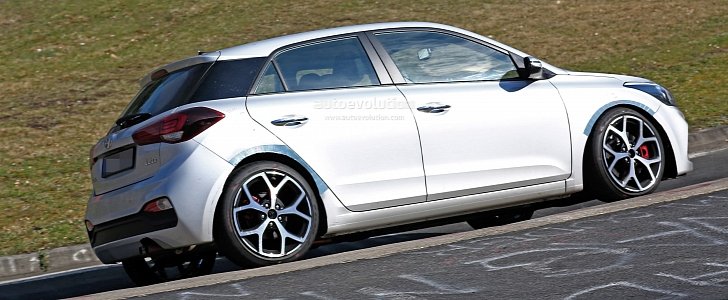After the i30 N and Veloster N, Hyundai prepares to roll out the i20 N in addition to go-faster versions of the Kona and Tucson. The subcompact hatchback has been spied for the first time ever at the Nurburgring, flaunting a dual-exit exhaust system, 18-inch Pirelli P-Zero performance tires, flared wheel arches, and red brake calipers.
The carparazzi managed to photograph the front fascia as well, and the cascading grille ticks all the right boxes. The halogen headlights and fog lamps appear out of place, but do remember this is a prototype. Similar to the i30 N, the i20 N will look much better in production-ready guise.
Opening the hatchback door reveals a strut bar that should help the vehicle’s handling by reducing body roll in the corners. The N-branded gear shifter features six forward ratios and short-throw action, but the rest of the interior appears to be i20 without N. Even the steering wheel, seats, and monochrome display for the infotainment are bone-stock standard.
Look even closer at the i20 N, and you’ll notice a longer wheelbase than the i20 subcompact hatchback. This is the sort of modification that promises great handling, complementing the additional width from the go-faster tires. The question is, what do you think Hyundai is hiding under the hood?
Previous reports on the i20 N suggest front-wheel drive, an electronic differential, and “at least 250 bhp” from a turbocharged engine. The output leads us to believe that Hyundai will utilize a four-cylinder engine, but it remains to be seen if the powerplant in question is the 1.6 or 2.0 T-GDI.
Taking the i30 N for reference, the 2.0-liter option develops 250 PS (247 horsepower) from the get-go or 275 PS (271 horsepower) with the Performance Package. Torque tops at 378 Nm, translating to 279 pound-feet.
In other words, the i20 N could be more potent than the Toyota Yaris GRMN, Renault Clio RS, and Volkswagen Polo GTI. Look forward to the Hyundai arriving at European dealerships sometime in 2020, probably in the second half of the year.
Opening the hatchback door reveals a strut bar that should help the vehicle’s handling by reducing body roll in the corners. The N-branded gear shifter features six forward ratios and short-throw action, but the rest of the interior appears to be i20 without N. Even the steering wheel, seats, and monochrome display for the infotainment are bone-stock standard.
Look even closer at the i20 N, and you’ll notice a longer wheelbase than the i20 subcompact hatchback. This is the sort of modification that promises great handling, complementing the additional width from the go-faster tires. The question is, what do you think Hyundai is hiding under the hood?
Previous reports on the i20 N suggest front-wheel drive, an electronic differential, and “at least 250 bhp” from a turbocharged engine. The output leads us to believe that Hyundai will utilize a four-cylinder engine, but it remains to be seen if the powerplant in question is the 1.6 or 2.0 T-GDI.
Taking the i30 N for reference, the 2.0-liter option develops 250 PS (247 horsepower) from the get-go or 275 PS (271 horsepower) with the Performance Package. Torque tops at 378 Nm, translating to 279 pound-feet.
In other words, the i20 N could be more potent than the Toyota Yaris GRMN, Renault Clio RS, and Volkswagen Polo GTI. Look forward to the Hyundai arriving at European dealerships sometime in 2020, probably in the second half of the year.






























